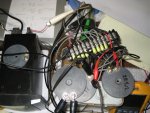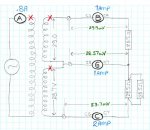MWBC with loads that are not compromised, a lost N will not be an issue, as long as both loads are on at the same time, the loads turn on and work. w/o the N one load by itself will not turn on.
take two 120ohm loads, one on one side the other on the other side. 240v CT 1ph xfrmer.
both are 1amp on half the xfrmer when only one is on. both on at the same time is still 1amp across each load with is now across the whole xfrmer. so what happens if the one load goes "bad" and is now just 60ohms. when both on you'll get more amps on the good 120ohm load, which is bad, right?
next, take 20 MWBC's, all red hots on one pole, all black hots on the other pole. now, if all the most used loads are on the red hots then you'll be loading the xfrmer heavily on only half the full winding. one half of the CT xfrmer gets real hot, the other side stays cold, etc.



